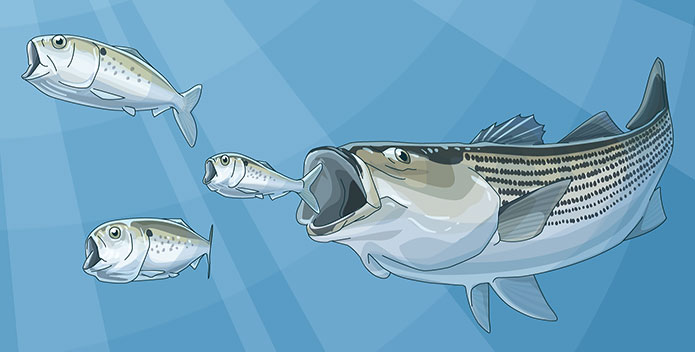The following was originally published in Bay Journal.
There's no question Atlantic striped bass are in trouble. Stock assessments show the fish, known locally as rockfish, are being overfished, and East Coast states have agreed to implement measures by April 1 that will cut the coastwide harvest 18 percent this year.
We can take another step to help striped bass recover. Protect their food.
A small, oily fish called Atlantic menhaden is a key prey species for striped bass and many other top predators in the Chesapeake Bay ecosystem, including osprey and whales. Menhaden are prized by humans, too. They support one of the largest and oldest commercial fisheries in the United States, with more than 170,000 metric tons harvested each year for use in products like fish oil and animal feed or as bait.
Management of the menhaden fishery does not currently take into account its critical role as a food source for other species. We now have the data and scientific models to do better.
At its February meeting, the Atlantic States Marine Fisheries Commission, the interstate body that sets fishing limits and rules along the East Coast, heard the results of a three-year, peer-reviewed effort to develop what are known as ecological reference points for menhaden. Ecological reference points essentially reflect how changes in the menhaden population affect populations of the fish that eat it—including striped bass, bluefish, weakfish and spiny dogfish—based on scientific models.
In other words, instead of relying on a best guess, we can now quantitatively say how many menhaden are needed to feed and sustain our desired populations of striped bass, bluefish and so forth.
My colleague, Allison Colden, who serves on ASMFC's Menhaden Management Board, introduced a motion at the February meeting to set ecological reference points for menhaden that would sustain the striped bass fishery. The board postponed a decision until it reconvenes in May.
When it does, it should adopt ecological reference points without delay. Doing so will not recover the striped bass population on its own, but it will make sure the rockfish out there have enough to eat.
And while there is still much more work ahead to develop a truly holistic ecosystem approach to management that accounts for the interactions of multiple predator and prey species—beyond striped bass and menhaden alone—this is a reasonable first step.
Striped bass, of all the predators studied, were shown to be the most sensitive to changes in the menhaden population. Therefore, adopting ecological reference points that protect striped bass will also protect other predator species that rely less on menhaden.
It is also important to note that adopting the new ecological reference points would not cause any changes in the current harvest quota for menhaden, though it would lower the threshold for overfishing.
Furthermore, ASMFC received more than 150,000 public comments on the current management plan for menhaden, which was approved in 2017. An overwhelming majority called for the use of ecological reference points to manage the fishery.
Adopting these reference points allows the commission to take action now to support the striped bass population, while it continues to work on bringing more species into the equation.




